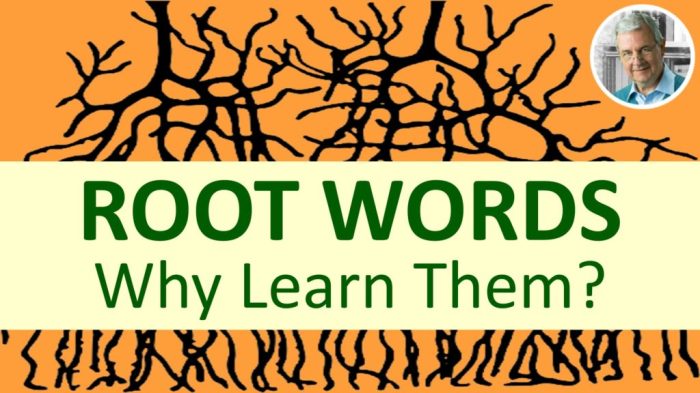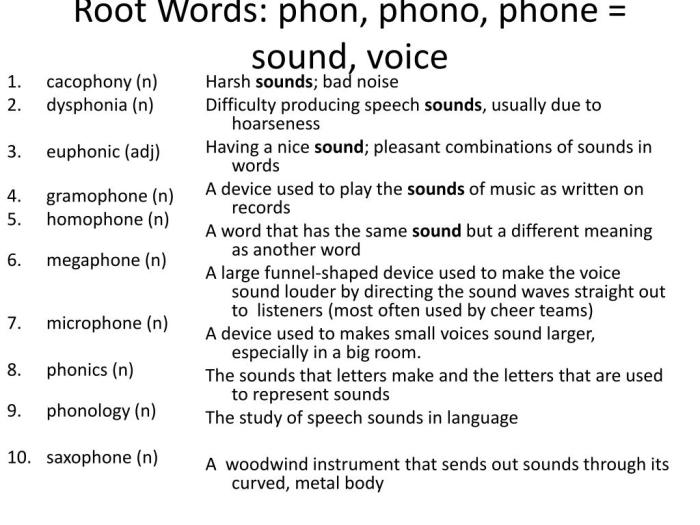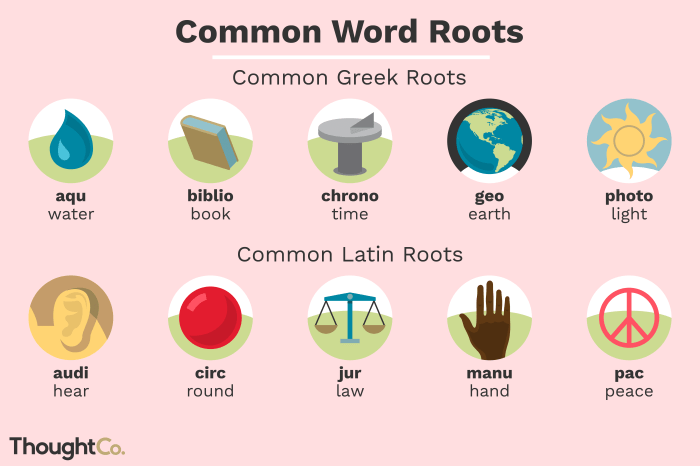Words with the root word phon – Words with the root word “phon” hold the key to unlocking the mysteries of language. From the building blocks of speech to the intricacies of literacy, this root word provides a lens through which we can explore the fascinating world of linguistics.
Prepare to embark on a journey where phonemes, phonology, and phonetics intertwine, revealing the hidden patterns and processes that govern our communication.
Phoneme Exploration
Phonemes are the fundamental units of sound in a language. They are the smallest units of speech that can be distinguished from one another. Phonemes are combined to form syllables, which are then combined to form words.
There are many different phonemes in the English language. Some of the most common phonemes include the vowels /a/, /e/, /i/, /o/, and /u/, and the consonants /p/, /b/, /t/, /d/, and /k/.
Phonemes are essential for understanding speech and communication. They allow us to distinguish between different words, even if they are spelled the same. For example, the words “cat” and “hat” are spelled differently, but they are pronounced with different phonemes, so we can easily tell them apart.
Examples of Phonemes with the Root Word “Phon”
- Phoneme: /f/ as in “phone”
- Phoneme: /o/ as in “phone”
- Phoneme: /n/ as in “phone”
Phonology and Phonetics

Phonology and phonetics are two closely related fields of linguistics that study the sounds of language. Phonology focuses on the abstract sound system of a language, while phonetics focuses on the physical production and perception of speech sounds.
Phonology
Phonology is the study of the sound system of a language. It investigates how sounds are organized and used in a language, and how they contribute to the meaning of words and sentences. Phonologists are interested in the rules that govern the combination of sounds, the distribution of sounds in words and sentences, and the relationship between sound and meaning.
Phonetics
Phonetics is the study of the physical production and perception of speech sounds. Phoneticians are interested in how sounds are produced by the vocal tract, how they are transmitted through the air, and how they are perceived by the ear.
They also study the acoustic properties of speech sounds, such as their frequency, intensity, and duration.
Phonetic Transcription
Phonetic transcription is a method of representing spoken language in a way that accurately reflects the sounds produced. It is used for a variety of purposes, including:
- Documenting and preserving endangered languages
- Teaching pronunciation in foreign language instruction
- Creating dictionaries and other reference works
- Conducting linguistic research
Phonetic Symbols
Phonetic transcription uses a set of symbols to represent the sounds of speech. These symbols are based on the International Phonetic Alphabet (IPA), which is a standardized system developed by the International Phonetic Association.
In the realm of language, words with the root word “phon” paint a sonic tapestry. They capture the essence of sound, from the vibrant symphony of music to the soft whisper of a lover’s voice. Exploring the depths of Frida Kahlo’s life and art, as depicted in Kristy Placido’s captivating biography Frida Kahlo by Kristy Placido , reveals the profound impact of these words.
Kahlo’s art echoed with the symphony of life, capturing both its joy and sorrow through vibrant colors and bold strokes. And so, we return to the root of “phon,” finding in words the ability to evoke the full spectrum of human experience.
The IPA includes symbols for all the sounds that are found in human languages. Each symbol represents a single sound, and there is no ambiguity in the transcription.
For example, the symbol [p] represents the voiceless bilabial stop sound, as in the word “pin.” The symbol [b] represents the voiced bilabial stop sound, as in the word “bin.”
International Phonetic Alphabet (IPA)
The IPA is an invaluable tool for linguistic research. It allows researchers to compare the sound systems of different languages and to study the evolution of language.
The IPA is also used in speech therapy and language teaching. It can help people to improve their pronunciation and to learn new languages.
Phonological Processes

Phonological processes are systematic changes that occur in the pronunciation of words as they are spoken. These processes can be applied to individual phonemes or to groups of phonemes, and they can have a significant impact on the way that words are pronounced.
Assimilation
Assimilation is a phonological process in which one phoneme is influenced by the pronunciation of a neighboring phoneme. This can happen in a number of ways, but the most common type of assimilation is when a phoneme is pronounced more like a neighboring phoneme.
For example, in the word “stop,” the /t/ sound is pronounced more like a /d/ sound because it is followed by the voiced /p/ sound. This is an example of regressive assimilation, in which a phoneme is influenced by a following phoneme.
Elision
Elision is a phonological process in which a phoneme is deleted from a word. This can happen for a number of reasons, but the most common reason is to make the word easier to pronounce.
For example, in the word “cannot,” the /t/ sound is often deleted because it is followed by the consonant cluster /nn/. This makes the word easier to pronounce and it does not change the meaning of the word.
Metathesis
Metathesis is a phonological process in which two phonemes are switched in order. This can happen for a number of reasons, but the most common reason is to make the word easier to pronounce.
For example, in the word “bird,” the /r/ and /d/ sounds are often switched in order, resulting in the pronunciation “brid.” This makes the word easier to pronounce and it does not change the meaning of the word.
Phonological Awareness: Words With The Root Word Phon

Phonological awareness is the ability to recognize and manipulate the sound structure of language. It is an essential skill for literacy development, as it helps children to understand how words are put together and how they can be broken apart into smaller units of sound.
Phonological awareness skills include the ability to identify and manipulate phonemes, syllables, and onsets and rimes.
Developing Phonological Awareness
There are a number of activities and strategies that can be used to develop phonological awareness in children. These activities can be incorporated into everyday play and learning experiences, such as:
- Playing rhyming games
- Singing songs and chanting rhymes
- Breaking words into syllables
- Identifying the first and last sounds in words
- Manipulating phonemes to create new words
Using Phonemes to Teach Phonological Awareness, Words with the root word phon
Phonemes are the smallest units of sound in a language. They can be used to teach phonological awareness by helping children to identify and manipulate the sounds in words. For example, you can use phonemes to:
- Teach children to blend sounds together to form words
- Teach children to segment words into individual sounds
- Teach children to identify the different sounds in words
- Teach children to manipulate sounds to create new words
Using phonemes to teach phonological awareness can help children to develop the skills they need to become successful readers and writers.
Phonemic Segmentation

Phonemic segmentation is the process of breaking down words into their individual sounds, or phonemes. This skill is essential for reading and spelling, as it allows children to understand the relationship between sounds and letters.Phonemic segmentation activities can be done in a variety of ways.
One common method is to use a sound box. A sound box is a box divided into compartments, each of which represents a different phoneme. Children can use the sound box to segment words by placing a chip or other object in the compartment that represents each sound.Another
method for teaching phonemic segmentation is to use Elkonin boxes. Elkonin boxes are a series of squares, each of which represents a phoneme. Children can use Elkonin boxes to segment words by placing a counter in each square for each sound in the word.Phonemic
segmentation can be challenging for some students, but it is an important skill for reading and spelling success. With practice, most students can learn to segment words into their individual sounds.
Benefits of Phonemic Segmentation
There are many benefits to teaching phonemic segmentation to students. These benefits include:
- Improved reading skills
- Improved spelling skills
- Increased phonological awareness
- Enhanced vocabulary
Challenges of Phonemic Segmentation
There are also some challenges associated with teaching phonemic segmentation to students. These challenges include:
- Some students may have difficulty hearing the individual sounds in words.
- Some students may have difficulty blending sounds together to form words.
- Some students may have difficulty representing sounds with letters.
Despite these challenges, phonemic segmentation is an important skill for reading and spelling success. With practice, most students can learn to segment words into their individual sounds.
Phonemic Awareness in Different Languages

Phonemic awareness is the ability to recognize and manipulate the individual sounds (phonemes) in spoken language. While phonemic awareness is a universal skill, it varies across languages.Cross-linguistic variations in phonemic awareness can be explored using the root word “phon.” The word “phoneme” refers to the smallest unit of sound that can distinguish one word from another in a particular language.
For example, in English, the words “cat” and “bat” are distinguished by the initial phoneme /k/ and /b/, respectively. In contrast, in some languages like Japanese, phonemes are not always clearly defined, and there is more overlap in the sounds used to distinguish words.
FAQ Overview
What are phonemes?
Phonemes are the smallest units of sound in a language that can distinguish one word from another.
What is the relationship between phonology and phonetics?
Phonology studies the sound patterns of a language, while phonetics focuses on the physical production and perception of speech sounds.
What is the purpose of phonetic transcription?
Phonetic transcription provides a systematic way to represent speech sounds using symbols, enabling researchers and linguists to analyze and compare different languages.